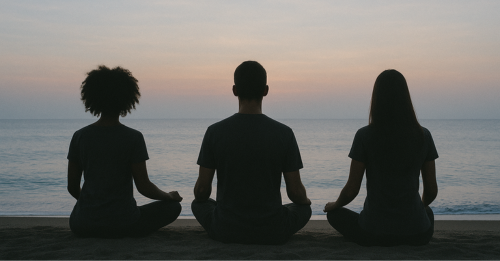The 3 “Orientations” of Meditation

By Mo Edjlali, Founder and CEO, Mindful Leader; Author, Open MBSR: Reimagining the Future of Mindfulness
The False Divide
Maybe you've heard the arguments:
"Workplace mindfulness is a betrayal, McMindfulness!"
"Contemplative practices don't belong here, stealth Buddhism!"
The spiritual practitioners cry corporate sellout. The pragmatists warn against religious infiltration. Both sides patrol the borders, checking credentials, questioning motives.
These divides exist for real reasons. Concerns about commodification are valid. Questions about cultural appropriation matter. Some worry that workplace mindfulness dulls our edge for systemic change. Others fear that spiritual approaches alienate those who just need practical tools.
But what if, instead of choosing sides, we held these tensions? What if we stopped policing each other's motivations and imagined an approach spacious enough for all who've found something valuable in this practice?
The Power of Not Knowing
The answer isn’t either/or but both/and in a dialectical way. It starts with being thoughtful about what we call the practices themselves.
Legacy MBSR got this right from the start, practices like "Body Scan" and "Awareness of Breath" are named for what they are, not what they promise. In Open MBSR, our community-centric adaptation, we're simply extending this principle across all practices. No predetermined outcomes. No hidden agendas. No Buddhist or spiritual names. Just the practice itself, trusting each person to discover what emerges.
In Open MBSR (Mindfulness-Based Stress Reduction), we name practices for what they are, not what they promise:
- Awareness of Breath: Following the natural rhythm of your breathing, use the breath as an anchor to return to when the mind wanders.
- Body Scan: Systematically bringing attention to different parts of your body, noticing whatever's there.
- Mindful Movement: Moving slowly and deliberately through different postures, bringing attention to the sensations of movement itself.
- Walking Meditation: Taking steps with full awareness, turning an everyday action into practice.
- Open Awareness: Resting in spacious attention without focusing on any particular object.
- Expansive Well-Wishing Practice: Cultivating positive intentions toward yourself and others.
The same practice lands differently for different people. It even lands differently for the same person depending on the day, the season, the chapter of life they're in. This approach welcomes all orientations. But what exactly are those orientations? Let’s explore them next.
Three Orientations
When people come to practice, they tend to orient themselves in three different ways. Think of these not as fixed identities but as currents we drift in and out of.
Restorative Orientation
- Focus: Healing and therapeutic approaches
- Who shows up: The insomniac mother at 3 AM. The veteran working through PTSD. The student drowning in finals week.
- What they're after: Emotional repair, stress reduction, building resilience from the ground up
Fitness Orientation
- Focus: Preventive care, capacity building, embodied awareness
- Who shows up: The athlete before competition. The surgeon needing steady hands. The teacher managing thirty energetic kids.
- What they're after: Mental clarity, physical vitality, cognitive sharpness
Contemplative Orientation
- Focus: Meaning-making, existential exploration
- Who shows up: The retiree facing mortality. The artist seeking inspiration. Anyone asking "What's this all about?"
- What they're after: Self-understanding, connection to something larger
Each orientation is valid. Each deserves respect. And most importantly, each can coexist in the same space, even in the same person.
The Beautiful Mess of Real Practice
These orientations don’t stay in their lanes.
The stressed-out executive chasing performance suddenly finds herself weeping, not from failure, but from recognition. The same practice that sharpens her focus also softens her heart.
The trauma survivor seeking healing discovers unexpected mental strength, standing taller than they have in years.
The spiritual seeker wrestling with life's meaning finds their anxiety settling into something manageable, even peaceful.
We can hold space for all of this: the CEO sitting next to the activist, the athlete breathing alongside the philosopher, healing and seeking and strengthening happening simultaneously.
Better Together
We've seen how the same practice lands differently for everyone, the executive finding tears, the survivor finding strength, the seeker finding peace. Meditation is solitary by nature, yet it comes fully alive in community.
Community isn't just nice to have. It's essential to the practice itself.
When we meditate together, the boundary between self-care and collective care dissolves. We're not just improving ourselves in isolation; we're creating networks of mutual care.
We're saying with our presence: "Your practice matters. Your healing matters. Your questions matter. You matter."
This runs counter to the solo-optimization journey, the self-improvement treadmill, the single-path dogma. But if community is the core, if we're truly in this together, then it's time to flip the script.
This is the future of mindfulness worth building: where all three orientations, restorative, fitness, contemplative, are all honored and accepted. Where your reason for showing up is simply your doorway in. Where the practice itself is incomplete without each other.
Imagine a space where titles dissolve and shared practice becomes the great equalizer. No defending territories. No checking credentials. Just humans, practicing together, each finding what they need.
Come as you are. Practice what calls to you. Respect our shared humanity and our different orientations. Discover what emerges, together.
What's your primary orientation? And what would it take for you to genuinely welcome all three?
This is part of our Wackfulness Series: a thoughtful critique of the mindfulness field.

0 comments
Leave a comment